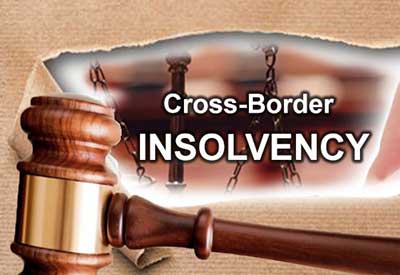Relevance: GS-2: Government policies and interventions for development of various Sector. Bilateral, regional and global groupings and agreements involving India and/or affecting India’s interests
Key phrases: Cross Border Insolvency, IBC 2016, Jet airways, Insolvency, bankruptcy, UNCITRAL, Section 234, section 235
Why in News?
- The incorporation of cross-border insolvency, where an insolvent debtor has assets and creditors in more than one country, into India’s IBC, will aid banks as foreign assets of large companies could now be brought under the ambit of the resolution process, improving recovery prospects, legal experts said.
What is Cross Border Insolvency?
- Usually, a situation concerning cross-border insolvency arises when the debtor has assets or creditors in different jurisdictions or when different insolvency proceedings have been filed in multiple jurisdictions.
- Typically, domestic laws prescribe procedures, for identifying and locating the debtors’ assets; calling in the assets and converting them into a monetary form; making distributions to creditors in accordance with the appropriate priority etc. for domestic creditors/debtors whereas the mechanism pertaining to cross-border insolvency is primarily focused towards regulating the insolvency proceedings that operate much beyond the realm of domestic jurisdiction and the constraints therein.
Examples of cross-border insolvency
An excellent example of successful cross-border
insolvency proceedings in India is that of the Jet Airways. Jet
Airways was facing insolvency proceedings in both India and the
Netherlands.
When the Dutch bankruptcy administrator made an application to the
National Company Law Tribunal (NCLT) for the recognition of the
insolvency proceedings in the Netherlands and putting a temporary hold on
the resolution process in India, the NCLT rejected it, citing an
absence of cross-border insolvency laws in India.
NCLT stated that while insolvency proceedings against the
corporate debtor have already been initiated before a District Court in
Netherlands, “there is no provision and mechanism in the IBC, at this
moment, to recognize the judgment of an insolvency court of any Foreign
Nation. Thus, even if the judgment of Foreign Court is verified and found
to be true, still, without the relevant provision in the IBC, we cannot take
this order on record.”
But on a subsequent appeal to the National Company Law Appellate Tribunal (NCLAT),
the tribunal’s decision was reversed, and it directed the Indian and
Dutch resolution professionals to ensure coordination and cooperation
through an agreement in September 2019.
Why cross-border insolvency is important?
Broadly speaking, the following aspects are involved in a cross-border insolvency:
- Equal protection of the interests of domestic and foreign creditors;
- Safeguarding the value of the assets of a debtor, which are located in different jurisdictions;
- Coordination and cooperation amongst courts and judicial authorities in various jurisdictions and the domestic laws applicable therein;
- Uniformity in the insolvency law and practices of different jurisdictions.
- Brought an investor friendly environment in the country.
Legal framework governing cross-border insolvency in India
- In India, the primary legislation governing insolvency and bankruptcy is the Insolvency and Bankruptcy Code, 2016. However, even though the Code has made strides in drastically harmonising the insolvency process in India, it does not account for a sufficient procedure to regulate cross-border insolvency proceedings. The Code offers two provisions that assist in cross-border insolvency disputes i.e. Section 234 and Section 235.
- Section 234 of the Code empowers the Central Government to enter into bilateral agreements with other countries for purposes of enforcing the Code.
- Section 235 of the Code empowers the adjudicating authority under the Code to issue a letter of request to a court in a country in which an agreement under Section 234 has been entered into, to deal with assets situated in that country in a specified manner.
- As can be seen, the current provisions under IBC are ad-hoc in nature and are susceptible to delay. Entering into mutual (reciprocal) agreements require individual long-drawn-out negotiations with each country. This leads to uncertainty of outcomes of claims for creditors, debtors and other stakeholders as well.
Way forward:
Therefore, there is a need for a standardized framework for Cross-Border insolvency. This issue is not new and in fact, the proposal to frame a robust cross border insolvency framework has already been highlighted in the report of the Insolvency Law Committee (ILC) in 2018.
The Committee had recommended the adoption of the United Nations Commission on International Trade Law (UNCITRAL) with certain modifications to make it suitable to the Indian context.
UNCITRAL on Cross-Border Insolvency,1997
UNCITRAL on Cross-Border Insolvency, 1997 has emerged as the most widely accepted legal framework to deal with cross-border insolvency issues. It provides a legislative framework that can be adopted by countries with modifications to suit the domestic context of the enacting jurisdiction. It has been adopted by 49 countries until now, such as Singapore, UK, US, South Africa, Korea, etc.
This law addresses the core issues of cross border insolvency cases with the help of four main principles:
-
Access: It allows foreign professionals and creditors direct access to domestic courts and enables them to participate in and commence domestic insolvency proceedings against a debtor.
- Recognition: It allows recognition of foreign proceedings and enables courts to determine relief accordingly.
- Cooperation: It provides a framework for cooperation between insolvency professionals and courts of countries.
- Coordination: It allows for coordination in the conduct of concurrent proceedings in different jurisdictions.
Source: Live Mint
Mains Question:
Q. Discuss the Legal framework governing cross-border insolvency in India. What should be the measures to frame a robust cross border insolvency framework in India? Critically comment.







